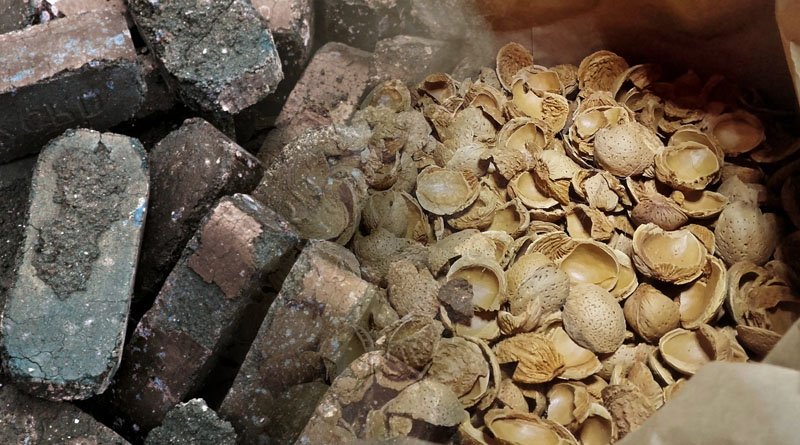Several biorefinery strategies are now using almond shells as their raw material to make a multiproduct biorefinery in cascade based on almond shells by making full use of them.

Biomass is one such environmentally friendly renewable resource that can be used to produce a variety of useful chemicals and fuels. A biorefinery, which is similar to a petroleum refinery, is required to produce fuels and useful chemicals from biomass.
Global concerns about the depletion of fossil fuels, climate change, and the growth of the world’s population have led to a number of new technological, social, and political ways to use natural resources instead of petrochemical ones. The new concept of energy production is biorefinery.
Biorefineries are called upon to play a vital role in this emerging global environment. One of the foundations of research in recent years is the idea of biorefineries, which are thought to be the greatest way to convert various biomass systems into high-value products like biofuels and chemicals.
In a biorefinery, alkaline and organosolv treatments are the ones that have been studied the most and are best for the environment. Lignin is taken out of lignocellulosic feedstock by organosolv treatments, which involve dissolving it in water or organic solvents (ethanol, methanol, etc.). These steps can be done in a wide range of temperatures (100–250 °C) and, most of the time, under high pressure.
Additionally, occasionally poor environmental or socio-economic management might have unfavorable effects. Around 2.1 million cultivated hectares of almond trees were grown globally in 2018, with 660,000 of those hectares in Spain. Almond trees produce between 70 and 150 million metric tons of almond shells every year. Since they have no known industrial or commercial use, they are usually burned for energy or carelessly thrown away in landfills, which can be bad for the environment.
To make these shells more useful, the goal is to create a multiproduct biorefinery in cascade based on almond shells by fully valuing them according to the circular economy model. With the suggested order, it would be possible to get several compounds that could be used as building blocks or platform chemicals.
Almonds are grown and eaten in many places around the world (INC-International Nut and Dried Fruit, 2019). According to FAOSTAT (2020), 2.1 million hectares of almond trees were actually grown in 2019—roughly 660,000 of those were in Spain.
Like most nuts, eating almonds makes a lot of shells. It would be advantageous for all parties involved and would advance the circular economy. Several biorefinery strategies are now using almond shells as their raw material.
Almond shells’ three primary parts were separated, identified, and extracted. The autohydrolysis method was used to get the hemicellulosic fraction out, and the result was a liquid with a high concentration of xylooligosaccharides (22.12 g/L).
Then, alkaline and organosolv treatments were suggested as two different ways to remove the lignin to make lignin that is very pure (>90%) and could be used for many different things.
Two distinct techniques were used to valorize the delignified solids’ high cellulose content. Creating cellulose nanocrystals on the one hand and extracting glucose by enzymatic hydrolysis on the other, together with a wasted solid that is primarily made up of lignin (78 wt%), might support a circular economy, since all the essential elements of almond shells could be valued through ecologically benign processes.
How it works
Almond shells can be used to make charcoal, torrefied shells, specialty carbon, biofuels, and synthetic gas because they are made of a strange material that is about 50% carbon.
In the current study, an indigenously made pyrolysis apparatus was used to pyrolyze almond shells that were both plain and laden with zinc oxide. Gas chromatography-mass spectrometry (GC-MS) was used to study the bio-oil made by catalytic and non-catalytic pyrolysis.
The primary ingredients in bio-oil made through non-catalytic pyrolysis are ethanol, acetic acid, 1-hydroxy-2-butanone, and 9-octadecenoic acid, while the key ingredients in bio-oil made through catalytic pyrolysis range in number from C5 to C57. Both samples were heated at rates of 5, 10, 15, and 20 °C/min during thermo-gravimetric analysis (TGA) in order to evaluate the kinetics of the pyrolysis reaction between ambient temperatures and 600 °C.
Degradation was seen to happen in four stages: the first stage was the removal of water molecules, the second stage was the breakdown of hemicellulose, the third stage was the breakdown of cellulose, and the fourth stage was the breakdown of lignin. Utilizing the equations of Coats-Redfern (CR) and Ozawa-Flynn-Wall (OWW), kinetic parameters were calculated.
The fact that the activation energy (Ea) and the frequency factor (A) both went up as the fraction conversion went up shows that the reaction has a complicated mechanism. It has been found that zinc oxide works well as a catalyst to lower the activation energy and improve the quality of the bio-oil that is made.
Advantages of Almond Shell
- Composite mixtures, such as cellulose or lignin fibers in wood-plastic composites (WPCs).
- Activated carbon found in personal care products or filter media.
- Specialty charcoals and firelighters can significantly lower hazardous emissions.
- Bio-based resins and wood adhesives.
Conclusion
The environment would be hurt the least by making almond shells useful in all ways on a large scale.
